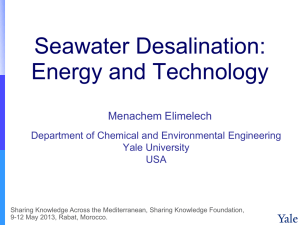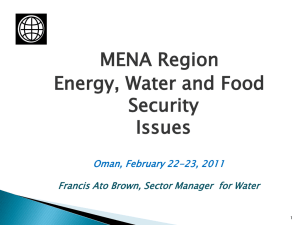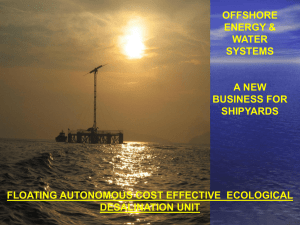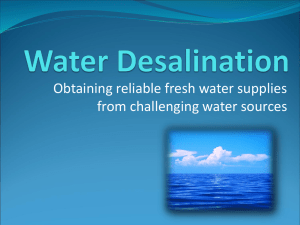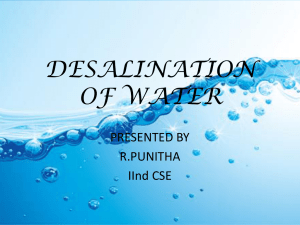Bridging the Water Demand Gap: Desalination
advertisement
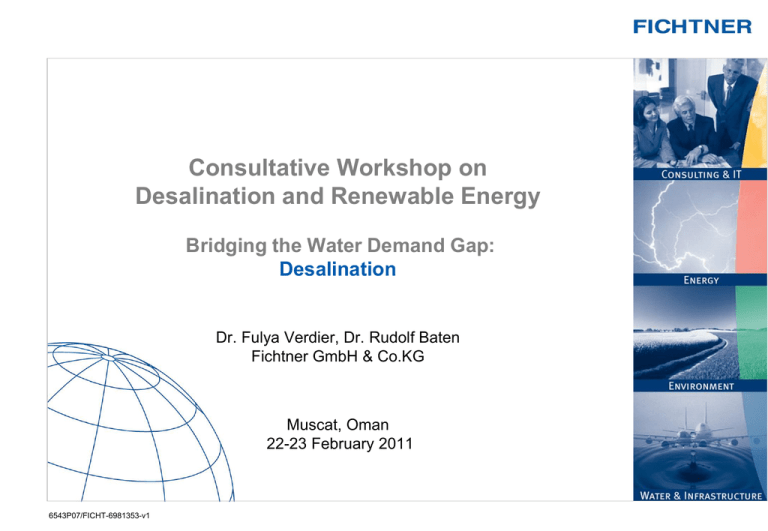
Consultative Workshop on Desalination and Renewable Energy Bridging the Water Demand Gap: Desalination Dr. Fulya Verdier, Dr. Rudolf Baten Fichtner GmbH & Co.KG Muscat, Oman 22-23 February 2011 6543P07/FICHT-6981353-v1 Mena Water Outlook, Part II Study objectives Identification of water gap Potential of solar powered desalination to bridge the gap Study approach Key criteria for technology selection Basic features of selected desalination technologies Definition of typical plants Current water situation in the countries of the MENA region Expected water gap in until 2050 Costs of desalinated water Potential of CSP to supply the required energy (separate presentation) 6543P07/FICHT-6981353-v1 2 Desalination & CSP Main drivers for new desalination projects Extent of water gap Financial strength of country (e.g. % of GDP spent for desalination) Experience with existing desalination facilities Attractiveness to investors (political stability) Development aid Main drivers for new CSP projects Peaking energy prices and undesired dependency on fossil fuel Limited availability of fossil fuel sources Reduction of carbon footprint Attractiveness to investors (political stability) Government incentives and regulations 6543P07/FICHT-6981353-v1 3 Desalination & CSP Key considerations for desalination plants MED, MSF and SWRO desalination technologies are well-proven Significant improvements achieved (i.e. energy efficiency) Capital and energy intensive Footprint of secondary importance Key considerations CSP plants CSP still in development status, including storage capacities Operational constraints due to limited solar radiation, back-up required Capital and energy intensive Footprint significant Is CSP the bottleneck? 6543P07/FICHT-6981353-v1 4 Desalination & CSP Design constraints for desalination plants Desalination plants are best operated at base load mode Design constraints for CSP plants Variable steam supply from CSP depending on solar irradiance (day/night) Fossil-fired back-up power plant Expensive heat storage Maximum live steam temperature is 370°C (compared to 480-560°C) Relative large footprint, especially for higher Solar Multiple (SM) Plants Largest CSP capacity to date ~ 100 MWe 6543P07/FICHT-6981353-v1 5 MED: Working principle of an MED unit 6543P07/FICHT-6981353-v1 6 MED: Process flow diagram of a 14 effect MED unit 6543P07/FICHT-6981353-v1 7 MED: Key design considerations (I) Capacity Unit production capacity (current maxium: 38,000 m³/d) Number of duty / standby units Energy demand Electrical energy demand (1.5 to 2.5 kWh/m³) Heat demand (order of magnitude: 70 kWh/m³) Steam demand calls for cogeneration of water and power Temperature profile Temperature of heating steam (upper process temperature) Seawater temperature (lower process temperature) Number of effects (performance ratio) 6543P07/FICHT-6981353-v1 8 MED: Key design considerations (II) Durability Plant availability and service time Material selection (e.g. Titanium tubes in top rows and alu brass tubes in below rows) Operational features Robust in regard to seawater salinity and bio-fouling potential High distillate quality Supplier market Major MED Suppliers: SIDEM (Veolia); others are following 6543P07/FICHT-6981353-v1 9 MED: One of 12 Fujairah F2 IWPP 38,640 m³/d MED Units 6543P07/FICHT-6981353-v1 10 SWRO: Working principle of a spiral wound module Feed at high pressure (100%) Concentrate at high pressure ( ≈ 60%) Permeate at low pressure (≈ 40%) Source: Dr.ir. S.G.J. Heijman, nanofiltration and reverse osmosis, 6543P07/FICHT-6981353-v1 http://ocw.tudelft.nl/fileadmin/ocw/courses/DrinkingWaterTreatment1/res00053/embedded/ !4e616e6f66696c74726174696f6e20616e642072657665727365206f736d6f736973.pdf, accessed on 20110218 11 SWRO: RO section of the Singapore 136,000 m³/d Plant 6543P07/FICHT-6981353-v1 12 SWRO: Key design considerations (I) Operational features Large membrane area and narrow flow cross section cause susceptibility to bio-fouling Pre-treatment process to be adopted to the seawater conditions Seawater salinity and temperature affect the power demand No perfect salt rejection – usually a second pass required Energy Electrical energy demand (order of magnitude: 4 kWh/m³) Absence of heat demand allows for stand alone configuration Method of energy recovery (Pelton turbine, turbocharger or isobaric system) 6543P07/FICHT-6981353-v1 13 SWRO: Key design considerations (II) Capacity and plant design Plant capacity (current maximum: 500,000 m³/d) Modularity allows a high number of process configurations (e.g. train or centre design) Durability Plant availability and service time Material selection (e.g. super duplex for high pressure section) Supplier market Major Suppliers: Befesa, Cobra/Tedagua, Degremont (Suez), GE, Hyflux, IDE, OTV (Veolia) 6543P07/FICHT-6981353-v1 14 SWRO: Flow diagram of a typical SWRO process Source: Victorian Desalination Project 6543P07/FICHT-6981353-v1 15 SWRO: Artists view of the Hamma (Algeria) 200,000 m³/d plant Source: IDA Yearbook 2008 - 2009 6543P07/FICHT-6981353-v1 16 Desalination Market Cumulative capacity put online in and outside the GCC countries 16 Capacity put online (cumulative) [Million m³/d] 14 MSF in GCC Countries MSF in non GCC Countries 12 MED in GCC Countries MED in non GCC Countries 10 SWRO in GCC Countries 8 SWRO in non GCC Countries 6 4 2 0 1950 6543P07/FICHT-6981353-v1 1960 1970 1980 Year 1990 2000 2010 17 Desalination Market Online Desalination Capacity sorted by technology and daily capacity 8 Total Online Capacity [Million m³/d] 7 6 5 4 3 2 1 0 MED MSF SWRO GCC Countries < 5 000 m³/d 6543P07/FICHT-6981353-v1 5 000 m³/d - 20 000 m³/d MED MSF SWRO Non GCC Countries 20 000 m³/d - 100 000 m³/d > 100 000 m³/d 18 Desalination Market Forecast Contracted Capacity by Technology (2006-2016) 6543P07/FICHT-6981353-v1 19 Desalination Market Additional Desalination Capacity (2008-2016), 12 MENA countries in TOP 20 ! 6543P07/FICHT-6981353-v1 20 Study Approach Desalination & CSP Potential Assessment DATA Water Demand & Availability TECHNOLOGY Solar & Land Assessment Desalination Installed Capacities + CSP Water Power TYPICAL PLANTS => Number & Location in MENA Region Potential Desalination CSP 6543P07/FICHT-6981353-v1 21 Desalinated Water-Share in MENA Water Resources and Water Withdrawals (1960-2010) Kuwait UAE Qatar Yemen Libya Saudi Arabia Malta Bahrain Water scarcity 1000 m³/cap/yr Jordan Total renewable per capita (actual) (m3/cap/yr) Israel Total water withdrawal (without desalination) per capita (m3/cap/yr) Algeria Djibouti Total desalinated water withdrawal (m3/cap/yr) Tunisia Oman Egypt Syria Morocco Lebanon Iran Iraq 0 500 1000 1500 2000 2500 3000 Source: FAO: Aquastat 6543P07/FICHT-6981353-v1 22 Technology Screening 6543P07/FICHT-6981353-v1 23 Plant Configurations Dual-purpose plant (MED-CSP) located at coast with seawater cooling Stand-alone plant with RO located at coast and CSP located in inland with air cooling Source: DLR, 2007 6543P07/FICHT-6981353-v1 24 Key Study Features Seawater Quality Desalination Process Product Water Quality 3 macro-regions MED / SWRO TDS < 200 mg/l MED Gulf SWRO Potable LARGE 200,000 m³/d Industrial MEDIUM 100,000 m³/d Irrigation Red Sea Mediterranean MEDIUM 100,000 m³/d SMALL 20,000 m³/d Increasing seawater TDS & temp. 6543P07/FICHT-6981353-v1 25 MED Typical Plant Design “Plain” MED Plant Basic Design Plant design parameters Dimension Data m3/d 100,000 % 94 Number of units No. 3 Unit capacity net m3/d 33,333 % 18 kg/2326 kJ 11.7 (1) Effects / unit No. 14 Seawater design temperature °C 28 Steam pressure bar 0.35 Steam temperature °C ~ 73 Net output capacity Average annual availability Recovery Performance Ratio Steam conditions (1) Considering potential future developments 6543P07/FICHT-6981353-v1 26 MED Typical Plant Requirements Energy requirement (1) (2) MED Plant Capacity [m³/d] Electrical Energy Demand [kWh/m³] Electrical Equivalent for Heat Demand [kWh/m³ distillate] 100,000 1.55 (1) [ 4.25 - 4.75 ] (2) Including seawater pumping, evaporation, post-treatment without potable water pumping Based on seawater at 28°C and final condensation at 38°C Area requirement MED Plant Capacity [m³/d] Area Requirement [ha] 100,000 1.5 6543P07/FICHT-6981353-v1 27 MED Typical Plants Fujairah F2 MED SWRO Hybrid Plant, UAE 464,600 m³/d 6543P07/FICHT-6981353-v1 Source: SIDEM 28 SWRO Typical Plant Design SWRO Plant Basic Design Net output capacity m³/d 100,000 % 94 Number of passes No. 2 Second pass capacity control Type Split partial configuration in 1st pass Energy recovery system Type Isobaric (Pressure Exchanger) Average annual availability 1st pass RO 2nd pass RO % 40 90 Type of membranes Type SW standard membrane R = 98% BW high boron rejection, caustic soda dosing Average membrane flux l/m2,h 13 - 14 33 - 37 Average annual membrane replacement rate %/y 15 12 Recovery 6543P07/FICHT-6981353-v1 29 SWRO Typical Plant: Energy Requirement Region @ selected seawater design parameters Mediterranean Sea & Atlantic Ocean @ TDS 39,000 mg/l & 15-30 °C Red Sea & Indian Ocean @ TDS 43,000 mg/l & 20-35 °C Arabian Gulf @ TDS 46,000 mg/l & 20-35 °C 6543P07/FICHT-6981353-v1 Pre-treatment Specific Energy Consumption1 [kWh/m³] FF1 3.5 MF / UF 4.0 Beach wells / sand filters 3.8 – 3.9 FF1 3.7 – 3.8 Beach wells / sand filters 4.2 DAF + FF2 4.2 – 4.3 Beach wells / sand filters 4.3 30 SWRO Design: Area Requirement SWRO Plant Capacity [m³/d] Pre-treatment Area Requirement 1) [ha] FF1 10 MF / UF 9 DAF + FF2 12 FF1 6 MF / UF 5 DAF + FF2 7 Beach wells / sand filters 1 200,000 100,000 20,000 1) FF1 including open gravity filters 6543P07/FICHT-6981353-v1 31 Evaluation Cases 4 evaluation cases are conducted in all macro-regions: MED-CSP at coast with seawater cooling SWRO and CSP at coast with seawater cooling SWRO at coast and CSP inland with air cooling SWRO at cost, CSP inland with “solar only” operation and air cooling 6543P07/FICHT-6981353-v1 32 CAPEX & OPEX Key Cost Data - Typical Plants Specific CAPEX (1) OPEX Unit MED RO US$/(m³/ d) 3100 1750 – 2400 US$/m³ 0.6 - 0.7 1.0 - 1.4 (1) Including pre-treatment, post-treatment, electrical and I&C equipment as well as civil structures including intake and outfall 6543P07/FICHT-6981353-v1 33 CAPEX & OPEX Cost Distribution – MED Typical Plant 16% 15% OPEX 32% 35% ENERGY CAPEX 53% Mediterranean DNI 2400 kWh/m²/yr Fuel NG 6543P07/FICHT-6981353-v1 49% Arabian Gulf DNI 2400 kWh/m²/yr Fuel NG 34 CAPEX & OPEX Cost Distribution – SWRO Typical Plant 22% 30% 21% OPEX 28% ENERGY CAPEX 48% Mediterranean DNI 2400 kWh/m²/yr Fuel NG 6543P07/FICHT-6981353-v1 51% Arabian Gulf DNI 2400 kWh/m²/yr Fuel NG 35 Evaluation Cases 4 evaluation cases are conducted in all macro-regions: MED-CSP at coast with seawater cooling SWRO and CSP at coast with seawater cooling SWRO at coast and CSP inland with air cooling SWRO at cost, CSP inland with “solar only” operation and air cooling For the electricity generation by CSP plant DNI classes: 2000 / 2400 / 2800 kWh/m²/y Fossil fuel options: Heavy Fuel Oil (HFO) / Natural Gas (NG) Electricity mix for “solar only” option 6543P07/FICHT-6981353-v1 36 Levelized Water Costs by MED Levelized Water Production Costs by MED Plant [US $/m³] 2.25 med_ DNI 2000_HFO 2.20 med_DNI 2000_NG med_DNI 2400_HFO 2.15 med_DNI 2400_NG Mediterranean red_DNI 2000_HFO 2.10 2.05 red_DNI 2000_NG Red Sea red_DNI 2400_HFO red_DNI 2400_NG 2.00 gulf_DNI 2000_HFO Gulf 1.95 gulf_DNI 2000_NG gulf_DNI 2400_HFO 1.90 gulf_DNI 2400_NG 6543P07/FICHT-6981353-v1 37 Levelized Water Costs by SWRO Levelized Water Production Costs by SWRO Plants [US $/m³] 1.90 med FF1_HFO_DNI 2000 med FF1_NG_DNI 2000 1.85 med FF1_HFO_DNI 2400 Gulf 1.80 med FF1_NG_DNI 2400 med MF/UF_HFO_DNI 2000 med MF/UF_NG_DNI 2000 1.75 med MF/UF_HFO_DNI 2400 1.70 med MF/UF_NG_DNI 2400 red FF1_HFO_DNI 2000 1.65 red FF1_NG_DNI 2000 Mediterranean red FF1_HFO_DNI 2400 1.60 red FF1_NG_DNI 2400 1.55 Red Sea gulf DAF+FF2_HFO_DNI 2000 gulf DAF+FF2_NG_DNI 2000 1.50 1.45 6543P07/FICHT-6981353-v1 Source: NETL gulf DAF+FF2_HFO_DNI 2400 gulf DAF+FF2_NG_DNI 2400 38 Bridging the Water Gap in MENA Water supply (MCM/y) based on within the average climate change scenario for MENA Year Efficiency Gains Unsustainable Extractions CSP Desalination Conventional Desalination Wastewater Reuse Surface Water Extractions Groundwater Extractions Total Demand BaU 6543P07/FICHT-6981353-v1 2000 2010 2020 2030 2040 2050 0 0 17,655 35,959 57,108 80,036 32,432 47,015 44,636 9,104 7,093 16,589 0 0 23,405 55,855 79,461 97,658 4,598 9,210 12,679 9,732 1,054 0 4,445 4,929 16,965 29,618 44,125 60,357 185,256 172,975 146,749 162,131 165,735 150,024 39,136 43,051 48,116 41,491 36,032 37,700 265,868 277,180 310,205 343,891 390,609 442,364 39 Bridging the Water Gap in MENA Excerpt: OMAN Water Production in MCM/y 2000 2010 2020 2030 2040 2050 Efficiency Gains 0 0 30 75 150 245 Unsustainable Extractions 0 0 0 0 0 0 CSP Desalination 0 0 0 536 1418 2032 Conventional Desalination 90 297 523 389 44 0 Wastewater Reuse 37 40 82 139 231 335 Surface Water Extractions 624 657 693 568 567 480 Groundwater Extractions 98 0 0 74 65 53 849 994 1328 1780 2475 3145 15 39 56 Total Demand BaU No of Desalination Plants* 0 0 installed *Reference desalination plant capacity: 100,000 m³/d 6543P07/FICHT-6981353-v1 0 40 Bridging the Water Gap in MENA Excerpt: SAUDI ARABIA Water Production in MCM/y 2000 2010 2020 2030 2040 2050 0 0 826 1606 2485 3271 9126 9299 7289 0 63 0 0 0 3400 2000 3434 3946 2950 286 0 160 158 1132 2144 3380 4611 Surface Water Extractions 6159 6154 6035 5528 5287 4393 Groundwater Extractions 4082 3297 2438 1911 1508 1227 21527 22341 25066 Efficiency Gains Unsustainable Extractions CSP Desalination Conventional Desalination Wastewater Reuse Total Demand BaU No of Desalination Plants* 0 0 installed *Reference desalination plant capacity: 100,000 m³/d 6543P07/FICHT-6981353-v1 93 14144 20172 23656 28283 33182 37158 388 553 648 41 Bridging the Water Gap in MENA Excerpt: LIBYA Water Production in MCM/y 2000 2010 2020 2030 2040 2050 0 0 41 90 151 220 560 183 0 0 0 0 0 0 0 1321 2487 2818 223 223 757 689 0 0 40 43 265 510 817 1153 Surface Water Extractions 821 871 915 963 1007 943 Groundwater Extractions 2529 3124 2862 1598 1290 1112 Total Demand BaU 4174 4444 4840 5171 5751 6247 36 68 77 Efficiency Gains Unsustainable Extractions CSP Desalination Conventional Desalination Wastewater Reuse No of Desalination Plants* 0 0 installed *Reference desalination plant capacity: 100,000 m³/d 6543P07/FICHT-6981353-v1 0 42 Bridging the Water Gap in MENA Excerpt: MOROCCO Water Production in MCM/y Efficiency Gains Unsustainable Extractions CSP Desalination Conventional Desalination Wastewater Reuse Surface Water Extractions Groundwater Extractions Total Demand BaU 2000 2010 2020 2030 2040 2050 0 0 1035 2118 3328 4487 498 0 1223 0 573 24 0 0 3400 6344 7904 8540 10 25 250 228 0 0 0 0 854 1804 2951 4192 13247 15043 8704 8097 6692 6870 1213 3148 2130 2160 1971 16387 16281 18613 2632 No of Desalination Plants* 0 0 installed *Reference desalination plant capacity: 100,000 m³/d 6543P07/FICHT-6981353-v1 93 20721 23608 26084 174 217 234 43 Conclusions Desalination has the potential to close the water gap (basically) Limitations may arise from environmental and financial aspects In most evaluation cases, SWRO appears more favorable, however certain circumstances may call for MED Energy is the major cost item for desalinated water Future developments of electricity cost will highly influence water production costs 6543P07/FICHT-6981353-v1 44
